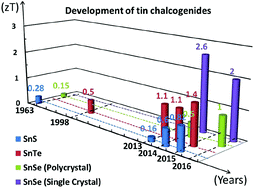Lead-free tin chalcogenide thermoelectric materials
Abstract
Thermoelectric materials can be used to directly and reversibly convert waste heat into electrical power and have attracted significant attention. Lead-free tin chalcogenide (SnTe, SnSe, SnS) thermoelectric materials are regarded as promising thermoelectric materials due to the great progress in the thermoelectric research field during the past several years. Analogous to PbTe, SnTe has a simple high symmetry NaCl-type cubic structure and a complex band structure, leading to its capability of achieving high thermoelectric performance by band structure and microstructure engineering. SnSe/SnS are simple compounds but exhibit an intrinsically ultralow thermal conductivity, suggesting that a high thermoelectric performance can be realized also in simple layered, anisotropic and anharmonic systems, without nanostructuring. This short perspective summarizes some current strategies that could enhance the thermoelectric performance of bulk lead-free tin chalcogenides, such as band structure engineering, nanostructuring, and synergistically improved approaches. Future possible strategies for further enhancing the thermoelectric performance of tin chalcogenides are also considered at the end of this perspective.

- This article is part of the themed collection: In honour of Mercouri G. Kanatzidis for his contributions to Inorganic Chemistry for over 30 years


 Please wait while we load your content...
Please wait while we load your content...